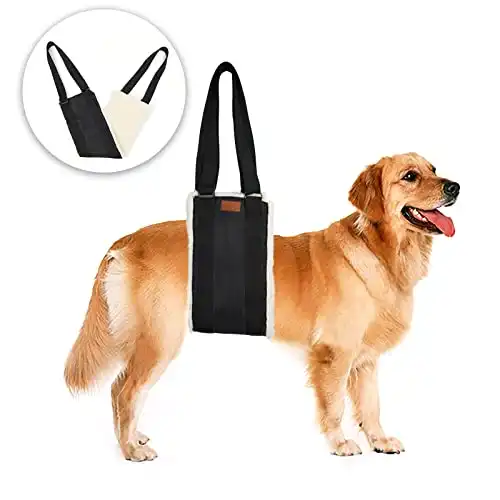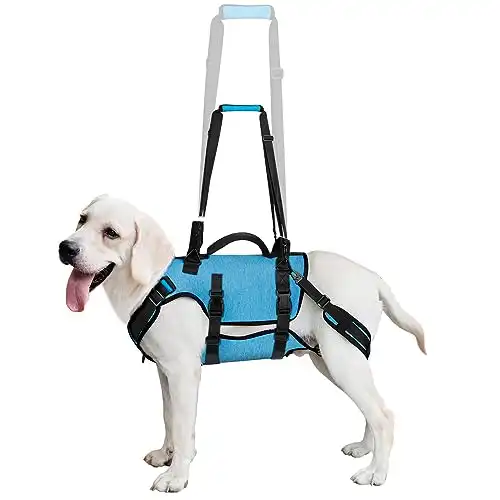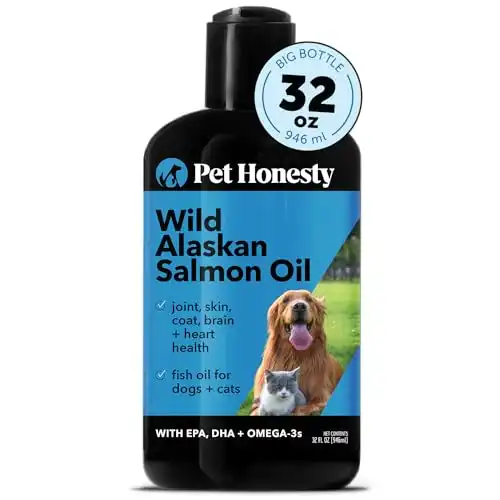Helping dogs have more fun with their humans!
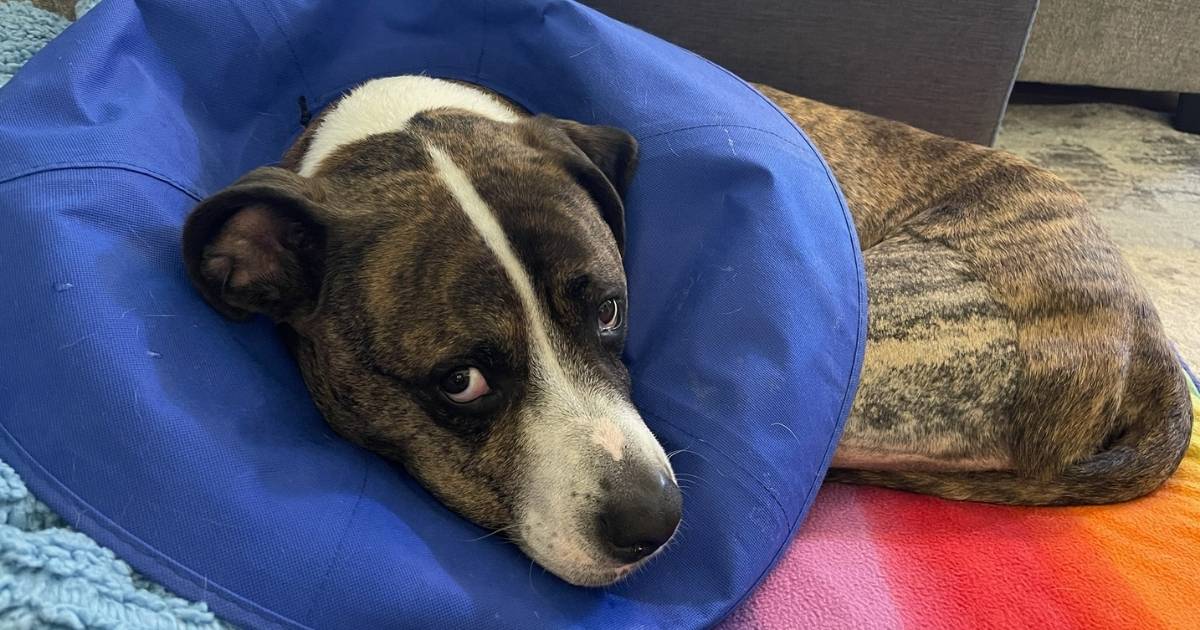

Dealing with cranial cruciate ligament (CCL) injuries can be overwhelming and stressful for both you and your furry friend. If you are like us, many different scenarios are going through your head and it can all get a bit overwhelming. The first two weeks, specifically the first few days, are by far the most stressful period of your dog’s ACL surgery recovery. With a little planning ahead of the procedure, we can get through this time with the least stress for you and get your pup back to playing without restrictions as soon as possible!
A few years ago, Goomba was playing in our backyard and shrieked while chasing after his favorite toy, this Hero boomerang. After the incident, he wouldn’t put any weight on his leg for several days. Eventually, he began to use his injured leg but was still limping heavily. Below is a video of the time between those two points.
At the time, we didn’t know what happened, but you can tell how little weight he was putting on it due to the bobbing of his head and twisting of his entire back when he moved.
When the full tear happens, it’s pretty easy to tell something went very wrong. There are a lot of less obvious signs that we missed, but are easy to see looking backward. We recommend checking out our article on the early dog ACL injury symptoms to help you see the signs before it gets as far as it did with Goomba. The earlier you can catch a potential injury, the easier it will be for both you and your dog to recover.
Goomba was referred to a canine orthopedic doctor and got in their queue for surgery, but that’s usually about a month before the consult if you’re lucky. We started consuming as much material as we possibly could find about keeping him comfortable leading up to his surgery, the options for surgeries and management, and any information on dog ACL surgery recovery we could find.
During the period between his initial consult and scheduled surgery, Goomba came to greet us when we got home, yelped, and began not using his other leg. We immediately knew what happened. Unfortunately, when your pup injures one CCL, there is a high chance the other will be injured as well due to compensating for the uninjured leg. We were devastated and resolved to get Goomba as healthy as possible, as quickly and safely as we could.
Fast forward a year and we’ve been through two surgeries to repair his CCL tears and a separate meniscus tear, as well. Our goal with this post is to provide our lessons learned so that your dog’s cruciate ligament surgery recovery is as smooth as possible.
Disclaimer
We’ll keep this part short, but we are not veterinarians, physical therapists, or any other medical professional. We are providing information on dog ACL surgery recovery for educational purposes by sharing our experiences from Goomba’s CCL injuries. We recommend following your vet’s instructions post-surgery and discussing any questions you have with your vet, orthopedic specialist, or other relevant professional.
Surgery for your dog’s CCL injury is a large and costly operation, and we recommend being as prepared as possible going into it to make recovery from dog ACL surgery as smooth as possible for both you and your dog.
Our top tips for dog ACL surgery recovery
Although our own experience is with Tibial Tuberosity Advancement (TTA), our tips apply to any CCL repair procedure for your dog, whether it is tibial plateau leveling osteotomy (TPLO), tibial tuberosity advancement (TTA), or a lateral suture procedure.
Prepare your dog for your support equipment
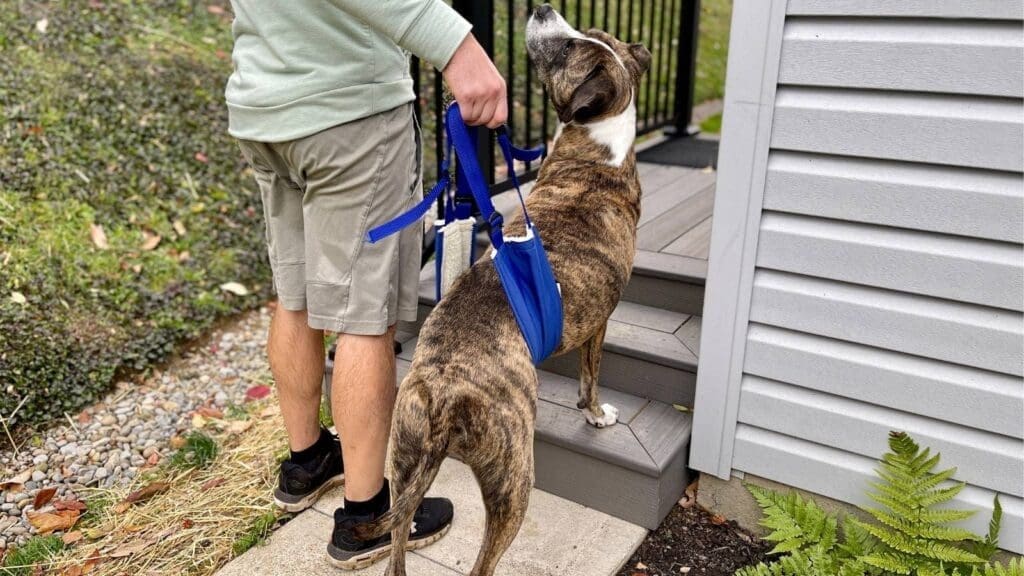

Preparing your dog for how you intend to help them move post-surgery is one of the most helpful actions we could have done to help be ready for Goomba’s recovery. We had a sling-style harness, that worked well enough, but there are better options, especially if you take some time to get your dog used to them.
We preferred the sling-style harness for Goomba during his injury and recovery from CCL surgery. It's easy to use, easy to clean, and cheap. It works slightly better for female dogs, but it's usable for male dogs, too.
Looking back, we should have tried a dog lift harness the first time through and saved ourselves the grief. There are ways you can get away with either, and we’ll explain when each is probably the better option.
Sling-style harnesses are much easier to use if you have a female dog or after your dog can put some degree of weight on their injured leg. As always, we recommend following the advice you get from your veterinarian, but ours had us let Goomba put as much weight as he wanted to on it, trusting him to know when it was ready to support his weight. Initially, he was heavily supported by the sling and after a week, he was able to use the bathroom without having support, even if we had to provide some assistance with walking.
With a male dog, like Goomba, there is a lot of shuffling around trying to get the placement right for the harness, especially the first few days when he didn’t want to use his leg still and wasn’t steady from the sedation. We ended up washing the sling-style harness frequently at first but didn’t have as much trouble once we got more accustomed to using it. We ended up getting a second one so that we could have one clean and one being washed at all times. With a female pup, like Prim, it would have been possible to use the sling-style harness the entire time.
A dog lift harness is preferable and easier to manage overall, as long as you prepare for it beforehand. Proper sizing and adjustment of the straps is an absolute must, especially if you have a male dog.
If you can size it properly, an easy lift harness is our preferred solution for limb injuries and recovery. It's much easier to manipulate your dog and you can provide support much more easily, even during bathroom breaks. We like how adjustable this one is, which can accommodate different size dogs and humans!
The first time we tried one with Goomba, our best guess at sizing wasn’t great. The harness ended up putting too much pressure on his underside and we ended up having to go back to the sling-style harness until we adjusted it properly. With a female dog, you have much more room for error, but it still needs to be sized and adjusted appropriately.
Overall, we’d recommend the sling-style harness for a female dog or if you get tired of dealing with the dog lift harness after your dog can support more of their weight. The dog lift harness is less effort when you’re moving around as long as you prepare for it properly. If you need help getting your dog used to a harness, we wrote an article on harness training your dog, which applies to this style of harness, as well.
Alternatively, if you’re willing to do a little more work, you can use a towel or a similar-sized piece of material in place of a sling-style harness, just make sure to use something soft so it doesn’t irritate your dog’s skin.
Be patient with your pup
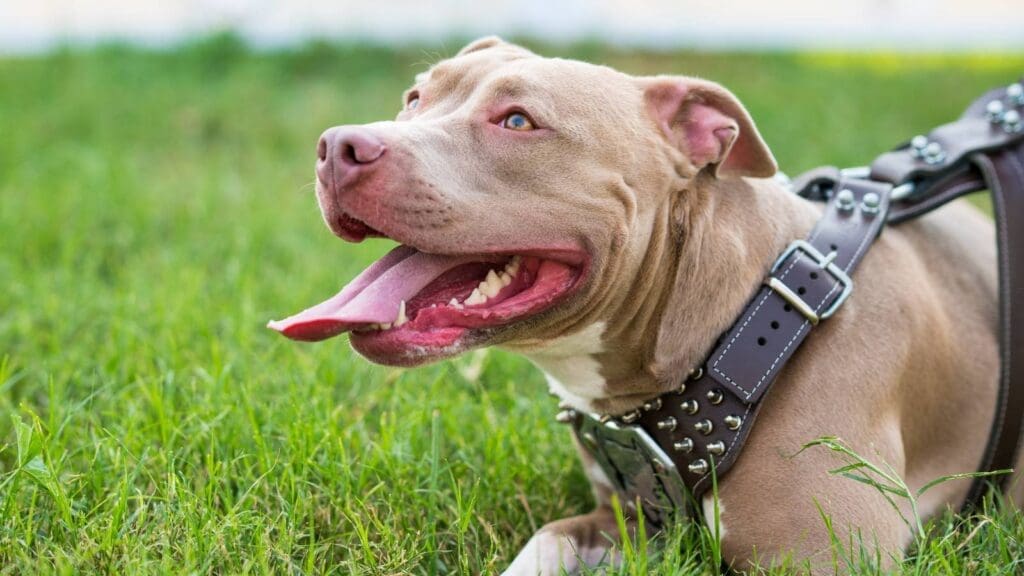

Of all these tips, the one we think is the most important is to be patient with your dog.
A lot of dogs whine from the pain or general discomfort for the first few nights during the initial period of dog cruciate ligament surgery. Your pup is confused, probably still sedated or otherwise out of it, and generally uncomfortable like you would be post-surgery. The difference is they don’t know why they feel that way. This, combined with the high degree of help your pup will need throughout the day, can result in a frustrating experience for both you and your pup, especially if you aren’t prepared.
It gets better after the first few days, so no matter how much you think it sucks initially, keep in mind it’s only a short time until your dog is much closer to being functional. Having a plan and knowing what to expect post-surgery will give you a good awareness of where to set your expectations for your pup’s recovery from your dog’s knee ligament injury.
We recommend asking as many questions as you can of your veterinarian or surgeon, and you can call us nerds if you want, but we took lots of notes so we wouldn’t forget anything. You get a lot of information extremely quickly during this period and your goal should be making your dog’s ACL surgery recovery as easy as possible for both you and your dog.
The constant care during the first few days to a week of recovery can wear you out as a pet parent. If you have any favors you can call in, try to get a friend who understands your dog’s temporary care requirements to watch your pup for you. Even if it’s only for 30 minutes or an hour for you to go to the store, it’ll help reset your patience. Sarah and I did this, even though we both work from home, to help prevent either of us from getting too frustrated or burnt out in the first few days post-surgery.
Have a plan for sleeping arrangements
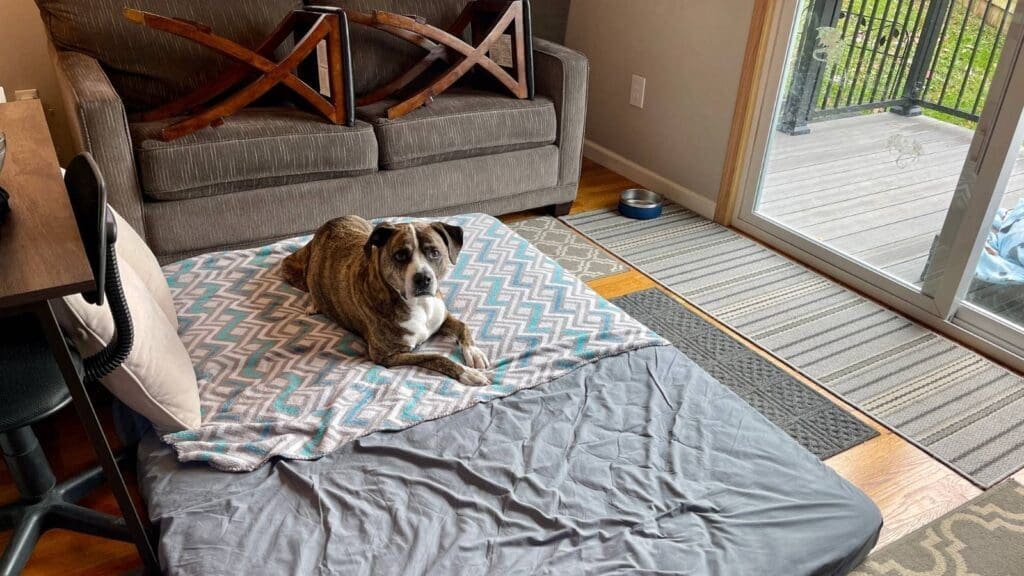

One of the main issues you will likely have to overcome during your dog’s ACL surgery recovery is sleeping arrangements. We weren’t as prepared for this as well as some of the other tips but we learned from our mistakes. Goomba’s second surgery went much smoother. As with most of these tips, a little bit of planning will make your and your pup’s time much easier and stress-free. The image above is what we had prepared for Goomba after his first CCL surgery.
Typically, when you pick up your pup from the veterinarian, there will be a lot of restrictions. Keeping your dog from licking their wound and preventing them from climbing onto elevated surfaces are two of the more challenging restrictions to manage. Depending on your normal sleeping arrangements with your dog, this can range from mildly inconvenient to a pretty big deal.
We recommend enclosing your dog in a room that’s easy to get to the outside and easy to block off from the rest of your living areas. For us, this was a room that had an exit to our yard and a sleeper sofa in it, which worked perfectly for our situation. We removed the mattress from the sleeper sofa and put it on the floor so Goomba could have a nice ground-level surface to lie on.
We covered all surfaces that Goomba might get on with blankets, towels, or sheets to ensure the surfaces he laid against were all as clean as possible. Goomba’s wound would periodically ooze and we could easily and quickly replace it with a clean blanket or towel while washing the soiled one. Keeping the wound clean is critical to help make a quick and infection-free recovery. Walmart typically has $3 blankets that work perfectly for this and a few of these can give you time to run laundry to keep everything as clean as possible.
Sarah and I rotated who supervised Goomba until he was able to be less observed. One of us would even sleep on the floor-bed with him for the first 5 or so nights. Rotating who was on “Goomba duty” allowed us to have a much better time while still keeping him from licking his wound and he was appreciative of the company.
If dedicating a room isn’t an option for you, here are some of the most important features of a good area to use for recovery from TPLO surgery:
- You’re able to hear your dog
- Non-slip flooring (check out our utility rug tip if you don’t have any carpet)
- Close to a way to go potty
- Open, unobstructed area (especially if you’re using your cone at night)
- Able to block off all the elevated surfaces your pup could get onto
If your vet suggests using a crate, we recommend thoroughly desensitizing your dog to the cone and making sure your dog is 100% used to their crate. An uncomfortable dog with a hard cone inside a crate can make them feel trapped and cause an extremely stressful situation. We wrote an article on the benefits of crate training and how to crate train your dog if you need some additional help with this.
Keep your pup from licking their wound
The most common complication during TPLO surgery recovery is your dog’s wound getting infected, typically from licking. We recommend consulting your veterinarian or surgeon to know which clinical signs they prefer to identify an infection. In our experience, discharge, fluid accumulation, and heat from the wound tend to be some of the more common signs of infection.
There are a variety of different options to help keep your dog from licking their wound during the stages of recovery. The most common is the E collar, or Elizabethan collar, which is a hard plastic shell sometimes called the “shame” cone.
Other options may be less stressful for your dog if they work for your situation. We used a cone similar to this soft recovery cone for Goomba most of the time since he was less bothered by it. Your vet may have options for you to take home with your pup as well. The soft cone we got from our vet wasn’t very stiff and often flopped down over Goomba’s head. If we had to buy another, we’d purchase the one linked because it is a bit more rigid.
When we have to prevent licking, we use and prefer soft cones. They're much less traumatic for your dog and make moving around much easier than hard cones. We were able to keep Goomba from licking his wounds with one of these for 3 different CCL related surgeries.
Soft cones work well but are possible to get around depending on your dog’s luck. Ours worked great for sleeping since our pups’ licking generally wakes us up anyway. We find this best for when you’re still with your dog but are focusing on something else like work, cooking, or working out.
There are also inflatable dog cones, which we did not have any luck at all with, despite a lot of positive reviews and recommendations. Maybe it’s just due to anatomy (we joke that Goomba has the neck and tongue of a giraffe), but Goomba could easily get at his wound with these. They seem to be best for smaller dogs or shorter-necked dogs. The inflatable cone may be much less obtrusive for your dog and takes away a lot of the issues you may encounter with the harder cones.
Condition your dog to your “shame” cone of choice


Depending on the type of cone you use, this may be one of the more time-consuming aspects of preparing for dog ACL surgery recovery. If you’re using an inflatable dog cone or soft recovery cone, there may not be much of a need for desensitizing. Elizabethan collars, or e-collars, typically require some additional preparation or desensitizing, unless you’ve used one before and know how your dog will react to wearing it.
Some primary issues with e-collars that can make surgery recovery more difficult include clunkiness and vision obstruction. If your dog isn’t used to wearing an e-collar, they might have a hard time grasping that they are no longer their normal width and bump into things. They also might not understand why their vision is restricted.
There are ways to make these less of an issue though. We recommend getting an Elizabethan collar that is at least close to transparent. A lot of e-cones are colored or white, but a transparent one will help allow your dog to see (somewhat) through the cone.
Our second recommendation is to make sure you make it as easy as possible for your dog to move around in the room with a hard cone. Essentially, we want to make the room as open or empty as possible, with as many non-slip surfaces as possible. This will help reduce the number of things your dog can walk into with their new cone and make recovery much easier for you and your dog.
We recommend checking out our section on restricting your dog’s potential activity when you’re unavailable and utility rugs are your dog’s best friend for a more thorough explanation on both of these points.
Condition your dog to be lifted or use a ramp


Due to the mobility restrictions during CCL surgery recovery, your dog may not be allowed to climb or jump onto surfaces such as couches, beds, car seats, or stairs. At some point, your dog will need to move to a higher surface and it’s crucial to have a plan for how to accomplish this. We used a mixture of lifting and a ramp to get past these issues, but a ramp is what we would recommend for most people.
We recommend getting a good dog ramp (we use this one which is from Chewy). It’s less effort for everyone if your pup can walk up the ramp, and a lot of dogs aren’t used to being picked up anyway. Once your dog isn’t as drowsy from being sedated, a ramp will allow them to do some minor climbing to get onto a couch or bed more easily.
We (and our pups) love this foldable ramp! It doesn't take up much space, is easy to move, and is sturdy. We use it for various agility movements, to help get Prim in the tub, and when Goomba had multiple leg surgeries. We don't think there is a better value for a safe ramp than PetSafe's ramp!
- Easy to move
- Siderails & non-slip surface help keep your pup on the ramp
- High weight capacity
- Weather resistant
- Not the best ramp for tall vehicles
For us, Goomba loves couches and definitely rested better during recovery on them than he did on the dog beds on the floor. We wrote an entire article on our favorite dog ramp for large dogs and the benefits of using a ramp. Check it out if you’re on the fence about getting one.
As a note, we also did a lot of picking up and moving Goomba, as well. During Goomba’s recovery from CCL surgery, we routinely moved him (he is approximately 80 lbs) up and down stairs, onto couches, or in cars by picking him up. We’ve done a lot of work with our pups over the years to get them used to being picked up safely to make our lives easier.
Even if you have a small dog, we don’t recommend doing this unless your dog is used to it. We’ve seen plenty of otherwise chill dogs react intensely to being picked up. If you’d like a resource to help get your dog used to being picked up, we recommend Rover’s guide on how to pick up a dog.
Vet prescribed sedation
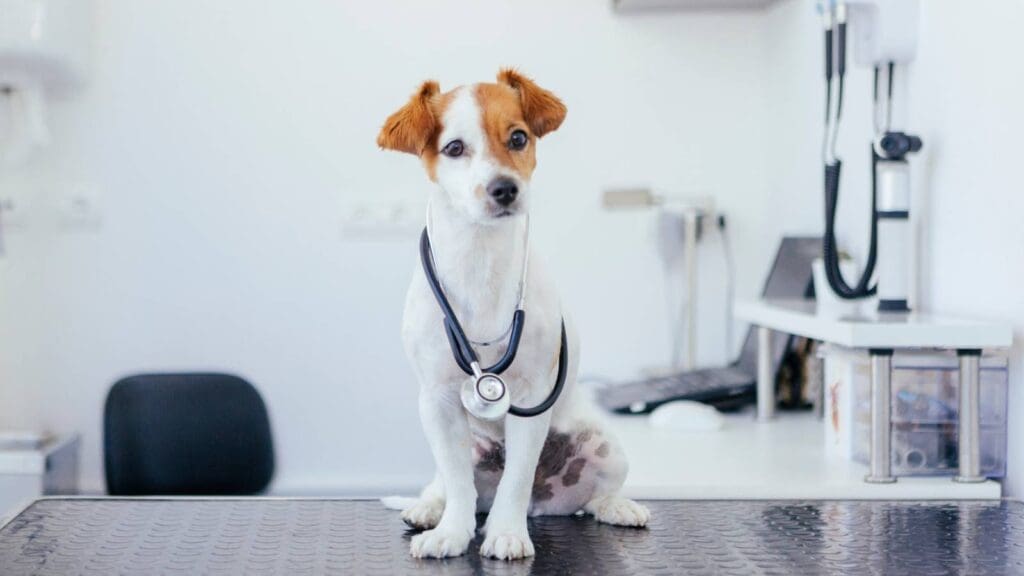

This is one of the tips we did not use the first time through that would have saved us a lot of grief. We don’t like using sedatives for our dogs unless we have to. Your dog’s vet may prescribe Trazadone or Gabapentin or something similar to keep your dog from moving around too much in the first few days of their recovery.
After Goomba’s first surgery, we ended up constantly trying to keep Goomba from moving too much or using his leg more than he was supposed to because we were stubborn about using sedatives.
Fast forward to the second CCL surgery and we swallowed our pride and used the prescribed medicines. It helped Goomba recover from his surgery faster since he was able to get some solid rest, seemed to help with the pain, and kept us a little more sane preventing him from licking or whining too much.
The time it took Goomba to be able to move around on his own was much shorter the second time through and we attribute it to having better rest for the first few days post-operation. Rest is critical in the first two to three days after any surgery because this is when the swelling and inflammation will decrease the most dramatically, and lead to a less painful healing experience for your pup.
Restricting your dog’s potential activity when you’re unavailable
The easiest way to make sure your dog doesn’t re-injure their leg is to dog-proof a room during their CCL injury recovery.
This is much easier to do in one room than a whole house, so we’d recommend getting a dog gate (or multiple). We’ve used a retractable dog gate similar to this one for years and we can’t recommend it enough. Whatever you choose, remove or block off any elevated surfaces your dog could jump onto. Think ottomans, chairs, couches, etc.. We used our dining room, which was able to be isolated from the rest of the house and was near a door to allow Goomba to go outside to potty.
Anything you can do to make it easier for your pup to succeed during recovery is a good idea. Goomba likes to bark at delivery drivers who stop at our house. To counter this, we temporarily disconnected our electronic doorbell. Alternatively, we’ve seen people put signs on their door instructing visitors not to knock or ring the doorbell. Whatever is easiest and works best for you is the preferred option. For us, people kept ignoring our sign and we got tired of dealing with it.
We used our dining room (without the table) for all the supplies we needed during Goomba’s recovery including cones, tons of blankets, a few flat dog beds, various harnesses, and his medicine. Once he was more mobile (closer to 1 week) we didn’t use it as much but it was extremely convenient for the first week. The blankets will prevent you from doing as much laundry if your pup’s wound leaks some, which is common post-surgery.
If you have hardwood or another slick surface, check out the utility rugs are your dog’s best friend section for how to make it easier to prevent your dog from slipping during their CCL surgery recovery.
Find some stationary enrichment activities to entertain your dog
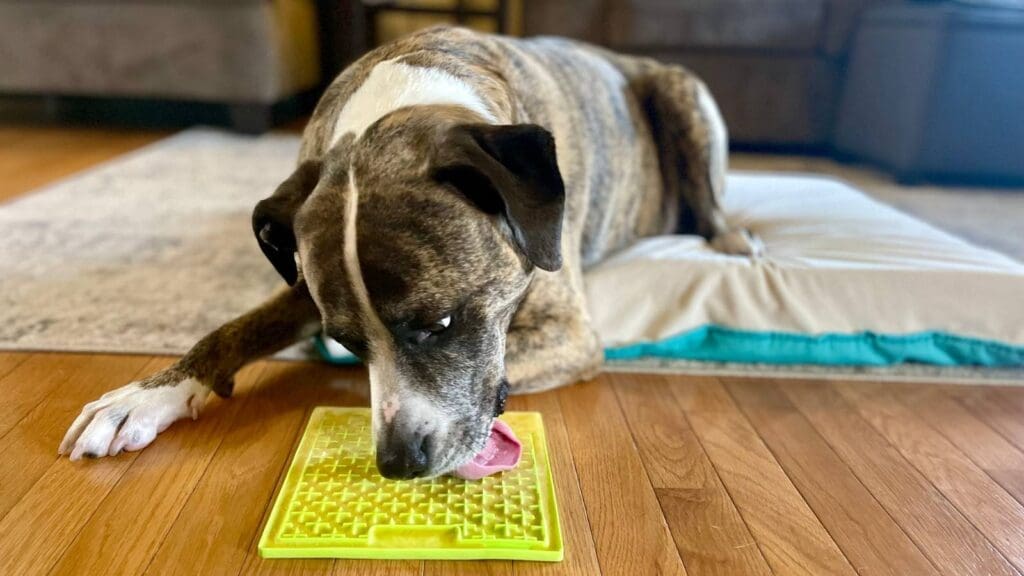

If you have ways to entertain your pup that don’t involve moving, your dog’s recovery will be a lot smoother. Our favorite stationary activities to start with are frozen lick mats, snuffle mats, frozen Kongs, and stuffed bones. All of these can be done lying down and are cheap, easy, and good ways to get your pup to use their mind. More than half of the ideas in our guide for how to make your DIY dog puzzles are perfect for mobility-restricted dogs.
From our experience, Goomba is moderately food-motivated but didn’t have any real interest in food-based enrichment for ~36 hours after surgery. When the post-surgery anesthesia was gone and he had a solid night or two of sleep, his appetite started coming back. Your experience may vary, but if your pup doesn’t express interest, you can easily put it in the freezer or store it and try again later.
As a bonus, if you happen to be busy, stationary enrichment activities can function as distractions to prevent your dog from licking their wound while you aren’t available. For example, some of these frozen Toppl recipes last 30 minutes or more for us! There’s no substitute for proper supervision, but these can help redirect their licking to something more useful during their recovery.
Utility rugs are your dog’s best friend
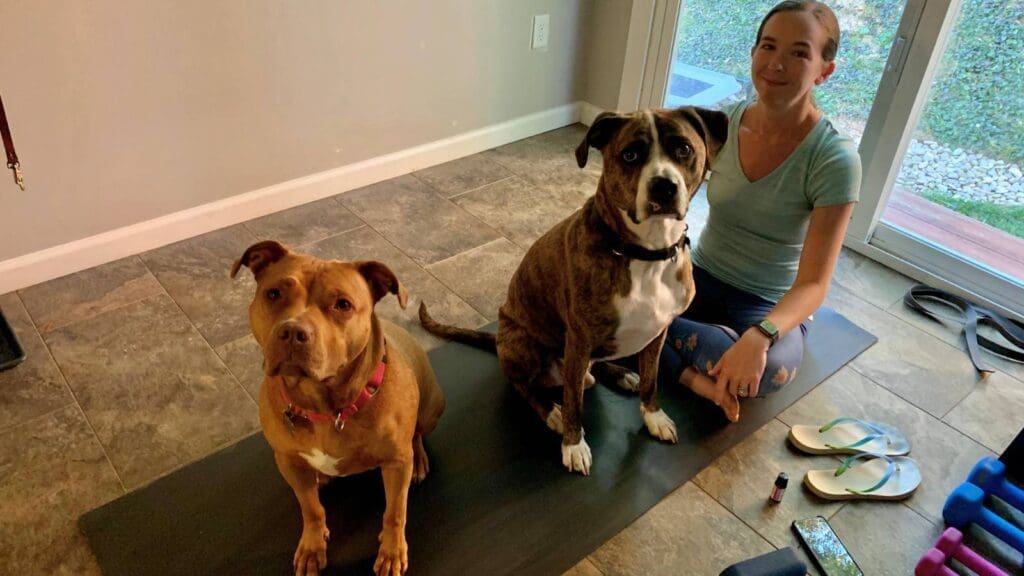

To prevent setbacks during your dog’s healing process, it’s important to make sure your dog doesn’t slip, fall, or strain their leg during ACL surgery recovery or similar procedures. If you have a carpeted room, you’re already in good shape. Our downstairs has vinyl and hardwood, which can be quite slick. Slipping during climbing or jumping are the most common issues we ran into.
We found that utility rugs are by far the most cost-effective way to prevent your dog from slipping. We used an existing area rug and filled in as much of the hardwood in our dining room with assorted utility rugs, exercise mats, and any other rugs from other rooms in our house (such as hallway runners or bathroom mats). We found that Walmart and Aldi had the cheapest options if you need to buy some, but any discount store is perfect.
The non-slip bathroom rugs are very good at staying put but are generally a lot smaller. The exercise mats and yoga mats were a preferred location for Goomba to walk since they rarely seemed to shift for us. As an aside, our dogs are infatuated with yoga or exercise mats and will go sit on them while we are still unrolling them.
Having all slippery surfaces covered is especially important during any leg surgery recovery since your dog is still unsteady from anesthesia. After your dog can move around better, you can gradually remove what you don’t need. Between the anesthesia and Gabapentin, Goomba wasn’t nearly as steady as he usually is.
Supplements to help with dog ACL surgery recovery
We used a few supplements to aid in our pups’ recovery. One of the most beneficial supplements for us, and the one our surgeon recommended, is a high-quality fish oil. We use PetHonesty’s Fish Oil and have had success with it. The benefits are the same as fish oil for humans (specifically, manages arthritis symptoms and reduces inflammation), and it’s a lot cheaper per dose than we thought it would be. Our dogs love it and the fish smell is much tamer than most other options.
PetHonesty's fish oil is our preferred option for a liquid fish oil supplement. We've used it for years and it's not a bad smell, even if you're sensitive to fish smells. The pump works and it comes with a dispensing cap to help get the part that's left that the pump has trouble with. Dosing is a breeze and we highly recommend it!
We also began and continue to use Glycanaid HA, which we highly recommend. It’s a little pricier but lasts a long time (even at the recommended dose for a larger dog). Even if you only use it for a little while after surgery, it’ll help expedite your dog’s recovery. For us, we noticed a large difference in our dog’s willingness to be more active, and it can help minimize the effects of other inflammation, arthritis, and other joint-related conditions.
We’ve also tried a few other supplements but didn’t notice a lot of difference, especially for the price they cost. One we tried was about $70 per month and we couldn’t even tell a difference. If your vet is passionate about something else, follow their guidance as closely as you’re able. We try to keep our recommendations affordable options.
Other resources for CCL-related information
Before our dog had surgery to repair his torn CCLs, we spent a ton of time reading and trying to find information to help us and Goomba out during his recovery. We found the following to be the most helpful options to get you started. Both are short, easy reads and may give you more ideas for questions to ask your veterinarian or surgeon.
The Essential Dog Owner’s Manual for CCL Injury: What to Do Before, During & After Surgery by Carla J. Spinelli
Carla J. Spinelli wrote our favorite resource on CCL injuries. Her book is easy to read, concise, and helpful. It gives you most of the information you need to know without reading a medical research paper. We highly recommend it! You can find The Essential Dog Owner’s Manual for CCL Injury on Amazon.
Carla does a great job of consolidating a whole bunch of information in one easy-to-read book. It's affordable and will give you almost everything you need to know about how to make your dog's recovery as efficient as possible post-surgery.
MedVet TTA & TPLO Recovery Guide
Another resource we love for CCL surgery recovery is MedVet’s TTA & TPLO Recovery Guide. Goomba had some muscle atrophy from his CCL injuries and we believe this guide, specifically the physical therapy protocol, was instrumental in helping him regain his mobility and strength. Whenever we go to our normal vet for checkups, she always remarks on how much better his muscles are in his back half than they were before his surgeries.
We’re not going to lie, it is a lot of work, but even if you only do what you’re able to, it’ll help get your pup back up and running as soon as your specialist allows them to. We highly recommend incorporating physical therapy into your dog’s surgery recovery if you have the ability or time to devote to it. Getting their quality of life back to normal is the goal of the surgery after all!
If you want to dip your toe in the physical therapy water, cavaletti for dogs is an easy physical therapy movement to try out first and can even work as a fun physical activity!
Conclusion
ACL surgery recovery is a stressful time for you and your pup. With proper planning and expectations, it can be much easier for you and your pup. Remember to be patient, and try to keep your pup from licking or re-injuring their wound, and you guys will be back to normal again in no time! Your pup can end up like Goomba here and be back to 100%, zooming around and chasing toys like a maniac again!
What are your favorite tips for CCL surgery recovery? Do you have other ideas that we didn’t list? Share your favorite advice with us on Instagram by tagging @therulybully.
Have fun!
